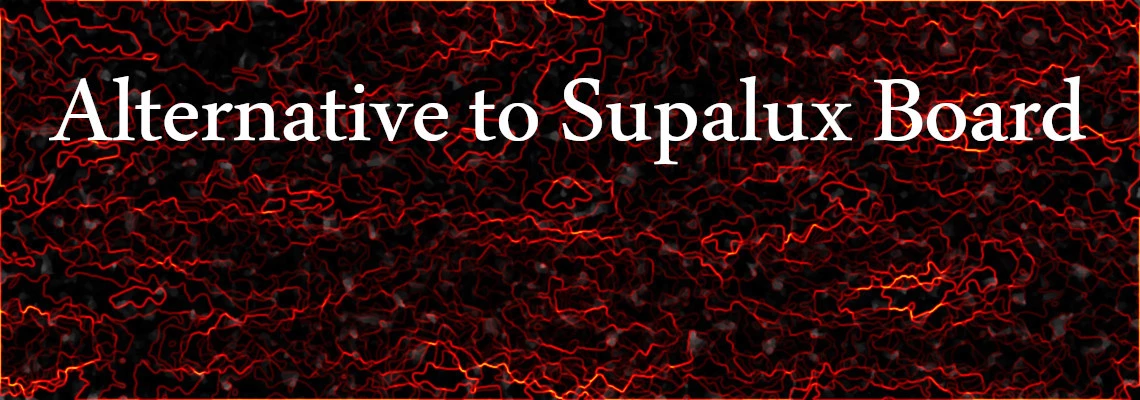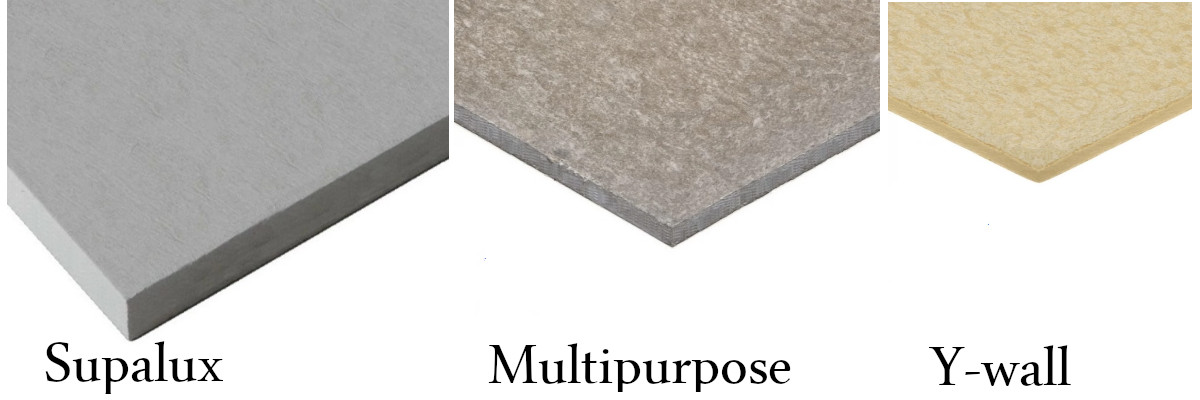
IS THERE ANY CHEAPER ALTERNATIVE TO PROMAT SUPALUX, MASTERBOARD?*
When we think of an alternative product, it is clear that we are looking for a cheaper option with similar or comparable properties. This is often driven by budget constraints, or high demands from architects. In this article, we will focus on A1 fire-rated boards called Supalux. We will present their closest alternative, compare their key differences, including price, and explore their features.
WHAT SETS SUPALUX APART?
To answer the question of what sets Supalux apart from its alternatives, we need to carefully examine their properties, weight, applications, fire resistance, and thermal conductivity.

DENSITY
Two alternative products to Supalux are RCM Multipurpose and its counterpart, RCM Y-Wall. Interestingly, Supalux has a significantly lower density, at 950 kg/m³, while Multipurpose weighs 1380 kg/m³, which is 190 kg/m³ more than Y-Wall's 1200 kg/m³ and 430 kg/m³ more than Supalux itself. Therefore, when it comes to density and weight, Multipurpose board is the best equivalent to Supalux, surpassing it by approximately 30% in weight. Thus, if additional sound insulation is desired, Multipurpose board becomes the ideal alternative to Supalux.
APPLICATION
While all three products, Supalux, Multipurpose, and Y-Wall, have very similar applications, such as internal and external walls, structural steel, or protected zones, RCM Y-Wall can be bent due to its bending strength of only 12 N/mm². Supalux is more commonly used in applications where longer fire resistance is required, but less frequently as an external sheathing board, despite being designed for that purpose.
FIRE RATING
Supalux is a non-combustible product that offers fire resistance ranging from 60 to 240 minutes. On the other hand, its alternative product, Multipurpose RCM board, has an A1 non-combustible classification, providing the highest level of fire-rated performance and holding a BBA approval. This makes it an excellent option for buildings over 18m in height (fire-rated to EN 13501-1 class A1 non-combustible). Y-Wall has a reaction to fire rating of BS EN 13501-1 Class A1, which also indicates a highly resistant nature.
THERMAL CONDUCTIVITY
When it comes to thermal conductivity, Multipurpose board emerges as the winner and the best substitute for Supalux, offering a value of 0.17 W/mK. This is approximately 26% higher compared to Y-Wall's value of 0.23 W/mK. Interestingly, the thermal conductivity of both Supalux and RCM Multipurpose boards is the same. Therefore, for the most commonly purchased board thickness of 12mm, they provide the same effectiveness in terms of cold and heat resistance.
WHY IS THE PRICE OF SUPALUX SO HIGH?
What contributes to the higher price of Supalux compared to its counterparts, Multipurpose or Y-Wall? It is primarily due to its increased fire resistance of up to 240 minutes and the associated chemical composition. If fire resistance is not the main selection criterion, alternative options like Multipurpose or Y-Wall can be used. However, if the highest level of fire resistance is required for the people inside the building, there is no better class of board than Supalux. Consequently, the price of Supalux needs to be higher, approximately £240 per board, compared to Multipurpose at £92, resulting in savings of around £148 per board. Although this difference in price may seem substantial, considering the level of protection it provides, Supalux remains the top choice. Multipurpose board, on the other hand, is the best possible substitute for Supalux. It is indeed 62% cheaper than Supalux but does not offer the same high level of long-term guarantees as Supalux does.
CONCLUSION
In conclusion, when seeking alternative products to Supalux, it is important to consider factors such as cost, density, applications, fire ratings, and thermal conductivity. While Supalux stands out for its high fire resistance and superior chemical composition, its higher price can be attributed to these qualities. For those prioritizing fire resistance, Supalux remains the top choice despite its higher cost. However, if fire resistance is not the primary concern, alternatives like Multipurpose or Y-Wall can be considered, offering lower prices and similar applications. Among these alternatives, Multipurpose board emerges as the best substitute, with its lower cost and comparable thermal conductivity. Ultimately, the choice between Supalux and its alternatives depends on the specific requirements and budget constraints of the project, balancing the need for fire resistance with cost-effectiveness.
Related articles:
THE ULTIMATE GUIDE TO 30-60-90-240 MINUTE A1 FIRE RATED BOARDS: BENEFITS AND APPLICATIONS
CEMENT BONDED PARTICLE BOARD FEATURES
THE INSULATION GAME: DON'T LET HEAT ESCAPE, WIN WITH PROPER INSULATION!
*All the information provided in the content published on Insulationgo blog is for informational and educational purposes only. Insulationgo LTD makes every effort to ensure the accuracy and timeliness of the content, but we do not assume any responsibility for any errors or omissions.
The information presented on this blog should not be considered as professional advice or a substitute for consulting relevant experts. Before making any purchase decisions or taking action based on the information presented here, it is strongly recommended to contact the product manufacturer directly to verify the details and ensure its suitability for your specific needs.
By using this blog, you acknowledge and agree that Insulationgo LTD shall not be held liable for any damages, losses, or inconveniences arising from the use or reliance on the information provided herein. This limitation of liability applies to all users of the blog, including but not limited to visitors, readers, and subscribers.










































































































